"We are what we repeatedly do. Excellence, then, is not an act, but a habit." --Aristotle
Address any questions or comments regarding this newsletter to the individual authors listed after each article or to its editor, Rick Weinzierl, 217-333-6651, weinzier@illinois.edu. To receive e-mail notification of new postings of this newsletter, call or write the same number or address.
In This Issue:
Upcoming Programs (for beginning and established growers)
Regional Reports (from southern and western Illinois)
Fruit Production and Pest Management (noninfectious disorders of fruits and vegetables; mites on brambles; degree-days and codling moth; more on spotted wing Drosophila traps)
Vegetable Production and Pest Management (catfacing of tomatoes, corn earworm, Colorado potato beetle)
Upcoming Programs
Check the Illinois SARE calendar for a full list of programs and links for registration.
http://illinoissare.org/ and http://illinoissare.org/calendar.php
Also see the University of Illinois Extension Local Food Systems and Small Farms Team’s web site at:
http://web.extension.illinois.edu/smallfarm/ and their calendar of events at http://web.extension.illinois.edu/units/calendar.cfm?UnitID=629.
- GAPs (Good Agricultural Practices) webinars, postponed to July, 2014. Call 815-933-8337 or email uie-gkw@illinois.edu for more information on webinar dates and registration, or contact a Local Food Systems and Small Farms educator in your area (see the staff list and contact info at the end of this newsletter).
- Illinois Summer Horticulture Field Day, June 12, 2014.. Schwartz Orchard, Centralia, IL. See www.schwartzfruitfarm.com and/or www.specialtygrowers.org for more information. For reservations, email www.ilsthortsoc@yahoo.com or phone 309/828/8929.
- Southern Illinois Summer Twilight Meeting Series, June 15, July 21, August 18, and September 15, 2014. 6:00 to 8:00 p.m. On farm programs at Tanglefoot Ranch, Simpson, IL on June 16; at The Corn Crib, Shawneetown, IL, on July 21; at a livestock operation TBA on August 18, and at Lipe Orchards, Carbondale, IL, on September 15. Pre-registration (at no cost) is required; see http://web.extension.illinois.edu/ghhpsw/ or contact Bronwyn Aly at 618-382-2662 or baly@illinois.edu.
- Illinois Vegetable Growers Association St. Charles Twilight Meeting, July 17, 2014. 6:30 p.m. at the St. Charles Horticulture Research Center at the corner of Peck Road and Illinois Highway 38, St. Charles, IL. For more information, contact Shelby Henning at 630-584-7254 or shenning@illinois.edu.
Regional Reports
From southern Illinois ... With warmer weather, plants have been putting on lots of growth, and many crops are perking up after the cold wet weather a couple of weeks ago. This week we have had spotty showers, with rainfall totals being highly variable from less than a tenth to over an inch. Consequently, soil moisture levels vary, with some areas still being fairly dry unless they have caught a shower.
Farmers markets have lots of asparagus, greens, strawberries, and other cool season vegetables, with the start of a few high tunnel tomatoes coming in. Reports are for a good peach crop (where we have them in the far south) and an average apple crop. There is lots of planting activity for summer vegetables such as cucumbers, summer squash, melons, and green beans. Early sweet corn plantings that were yellowed due to poor nutrient uptake and root growth from the cool, wet period two weeks ago have bounced back and have greened up nicely with warmer conditions.
At home on the farm, potatoes are doing well with a few flower buds showing on ‘Kennebec.’ Make sure to be scouting potatoes for Colorado potato beetles. I first noticed a few about two weeks ago and have been monitoring and spraying accordingly. If uncontrolled, Colorado potato beetle adults and larvae can defoliate plants very quickly. See the article below about this insect and refer to the 2014 Midwest Vegetable Production Guide for management options. Other notes from home ... blueberries are looking good, with lots of green fruit starting to increase in size. I also have a good crop of tart cherries, which are just starting to get some pink and red on a few fruits. So barring no hail or other calamity, I think I see a fresh cherry pie coming in a week or two!
Nathan Johanning (618-939-3434; njohann@illinois.edu)
At and around the Dixon Springs Ag Center ... Raspberries are beginning to ripen in high tunnels in southern Illinois. Unfortunately,. spider mites are also becoming problems on raspberry leaves. Although we have routinely had spider mite issues on raspberries in high tunnels, this year the problem is presenting itself a month or more ahead of normal. Growers will need to address this issue with either pesticides or predators but regardless they must be addressed. (See the article below on mite management in brambles.)
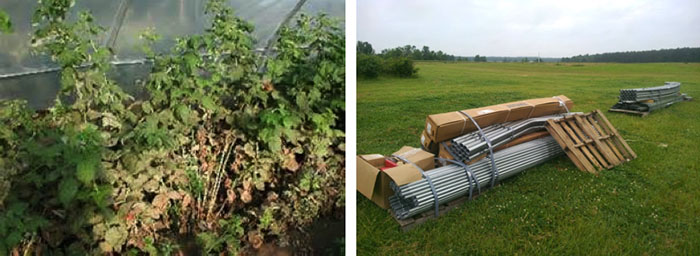
Left: Severe mite damage to raspberries (not a current photo from Dixon Springs, but an illustration of what can develop). Right: High tunnel components ... plenty of work awaits.
We received a new high tunnel this week. For those that have not been through this, the first step, which is unloading the truck, is among the most difficult. Our thanks go out to local producer Grover Webb for his assistance and machinery to help us get the truck unloaded.
We have five interns who started here last week. Their projects involve hydroponic herbs, oyster mushroom production, use of fresh fruit in the form fruit leathers, and using dried fruit in conjunction with chocolate to make value added products.
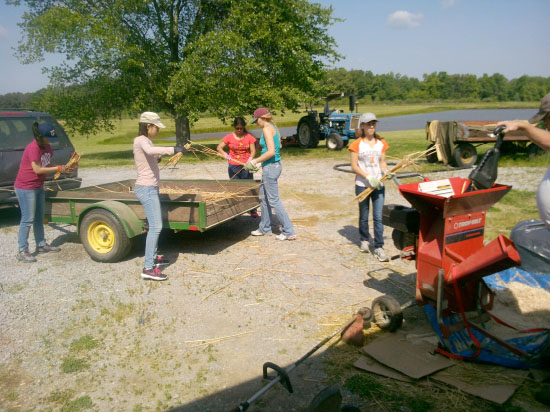
Summer interns at the Dixon Springs Ag Center.
Jeff Kindhart (618-695-2770; jkindhar@illinois.edu)
From western Illinois ... This past week saw lots of field work. Planting continues, although topsoil moisture levels are very low and subsoil moisture levels are worse. Field tiles have run only once since last July, and that was after some of the rains in April. The last decent rain we've received was over 2 weeks ago, and soils are beginning to dry out. I started our last sweet corn planting Wednesday evening, no tilling, and after setting the planter the deepest it would plant, am doubtful that there is enough moisture to germinate the seed. This may be a long summer.
The evening of May 17 saw temperatures dip into the 30's. Some locations had heavy frost while others just a light frost. At least one grower used row covers to protect recently transplanted tomatoes successfully.
Harvest of green onions, radish, lettuce and other assorted greens continues, and plasticulture strawberry harvest has begun. This is one of the latest start dates in recent memory. Our yields will be down compared to past years due to a cooler fall which didn't allow many branch crowns to develop. Matted row Earliglow strawberries are just beginning to color, so harvest is a week or so away.
Blueberry bushes are showing the effects of a harsh winter. Depending upon location and variety, some bushes are completely killed and are showing new growth from the crown and lower buds, while others show minimal injury and are fully leafed out. Variety differences account for differences in maturity, as some are still in flower while others have decent sized berries. Florocane blackberries are in bloom while raspberries show small berries.
Mike Roegge (217-223-8380; roeggem@illinois.edu)
A little further north in western Illinois (the Galesburg area), we received a much needed rain over the Memorial Day weekend. Almost all the transplants that had been waiting to get outside are in the ground now and are looking good, and warmer season crops have finally been planted.
I mentioned in an earlier report that we are investigating no-till tomato and pepper production into crimped rye this year at a plot at the U of I research and demonstration center in Monmouth. This trial went in last week, and I thought I would offer a few observations based on how things went in. First, it was difficult to get a good stand of rye cover this past fall in Illinois. We were lucky, I guess, because we had a tremendous stand to work with. We used an implement called a Dyna-Drive to roll over the rye in order to crimp and destroy the stems. You wouldn’t need such a large piece of equipment if you have a small plot. I have seen a grower build a crimper from a lawn roller. The key is to get the stem crimped at the correct time (just prior to heading) and get multiple fractures of the stem. We accomplished this by multiple passes across the field. We initially tried just one pass, but the stems stood up by the next day. The tomatoes and peppers were hand planted. I am not sure how easily a water wheel planter would work, if at all, in theses planting conditions. If you have tried this, please send me a note. I will submit further reports from this demonstration trial as the season progresses.
Kyle Cecil (309-342-5108; cecil@illinois.edu)
Fruit Production and Pest Management
Some Disorders (Noninfectious Diseases) of Fruit and Vegetable Crops
In addition to infectious diseases of plants (caused by fungi, bacteria, viruses and nematodes), there are many noninfectious diseases or disorders of crops and other plants. Major causes of disorders are temperature and moisture extremes, insufficient light, lack of sufficient oxygen, air pollution, nutrient deficiencies, mineral toxicities, soil acidity or alkalinity (pH), toxicity of pesticides, and improper cultural practices.
Every year, we observe damage caused by herbicides (often 2,4-D and glyphosate) on grapes, tomatoes, and apples. In 2014, we have observed more glyphosate damage on pears (Figure 1) and apples (Figure 2) than the past. Glyphosate that drifts onto trees after late spring may not show damage in the year of application. Instead, the glyphosate is stored in the tree and then causes disorders during the following season (as shown in the photos). Golden Delicious trees have been affected by glyphosate more than other apple varieties. Damage from 2,4-D on grapes (Figure 3) can be observed in almost all vineyards in Illinois in July. Also, injuries by low temperature (~32°F) on watermelon (Figure 4) were observed in central Illinois following the low temperatures in the second week of May.
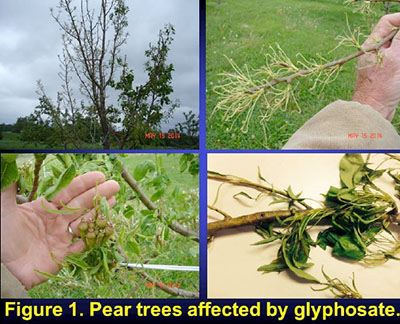
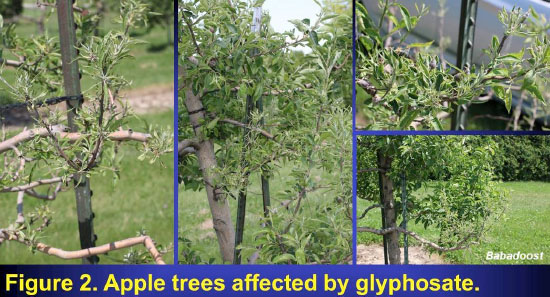
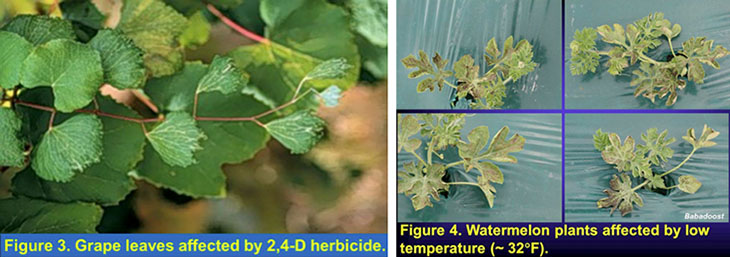
Mohammad Babadoost (217-333-1523; babadoos@illinois.edu)
Mites on Brambles
Jeff Kindhart mentioned twospotted spider mite infestations developing on raspberries in one of the high tunnels at Dixon Springs. Unfortunately, spider mites are a common problem in high-tunnel raspberries (and other crops in high tunnels as well). Where mites are building up, growers have two options – miticides or the release of predators for biological control. Miticides registered for use on brambles include Acramite, Savey (the same active ingredient is also sold as Onager), and Zeal. Organic growers may get some control with repeated sprays of insecticidal soaps. For all miticides, very thorough coverage is essential for good control. Miticides and predators cannot be used at the same time for what should be an obvious reason – the beneficial predators sold for use in biological control are mites, and most miticides kill them. If you choose to use biological control and purchase/release predators, you must begin releasing predators when mites are first observed and before populations reach high numbers and leaves begin to show yellowing or bronzing. The two suppliers of biological control agents (predaceous mites in this case) that have been most involved in working with growers in Illinois are Koppert (810-632-8750) and BioBest (877-505-9703). Contact them to ask questions about biocontrol, explain your circumstances (crop and infestation level, temperatures in the tunnel, etc.), and purchase mite predators.
Rick Weinzierl (217-244-2126; weinzier@illinois.edu)
Degree-Days and Codling Moth Development
Based on the biofix dates for the locations listed below, degree-day accumulations (base 50F) since biofix for each location (based on the closest regional weather stations) are ...
Location |
Biofix Date for codling moth |
Degree-Days base 50F, through May 27 |
Degree-Days base 50F, projected through June 5 |
Degree-Days base 50F, projected through June 12 |
|---|---|---|---|---|
Milstadt / Belleville |
April 27 |
468 |
588 |
722 |
Grafton |
May 6 |
363 |
480 |
616 |
Urbana |
May 9 |
280 |
323 |
508 |
Lake County |
May 21 |
121 |
199 |
297 |
Some key events in the codling moth’s life cycle in comparison with degree-day accumulations (based on Table 6, p. 260, in Orchard Pest management, A Resource Guide for the Pacific Northwest, by Beers et al, published by the Good Fruit Grower in 1993) ...
Degree-Day Accumulations (Base 50 F) |
First-Generation Flight |
First-Generation Egg Hatch |
Second-Generation Flight |
Second-Generation Egg hatch |
120 |
19 percent complete |
|
|
|
200 |
40 percent complete |
|
|
|
240 |
50 percent complete |
2 percent complete |
|
|
360 |
70 percent complete |
20 percent complete |
|
|
500 |
90 percent complete |
54 percent complete |
|
|
600 |
96 percent complete |
73 percent complete |
|
|
700 |
99 percent complete |
87 percent complete |
|
|
800 |
100 percent complete |
95 percent complete |
|
|
900 |
|
98 percent complete |
1 percent complete |
|
1,000 |
|
100 percent complete |
5 percent complete |
|
1,100 |
|
|
13 percent complete |
1 percent complete |
1,200 |
|
|
26 percent complete |
3 percent complete |
1,300 |
|
|
43 percent complete |
10 percent complete |
Codling moth egg hatch begins at approximately 220 degree-days after biofix, and application timing for different insecticides varies from 100 to 250 degree-days after biofix. See page 23 of the 2014 Midwest Tree Fruit Spray Guide for listings of recommended timing for different insecticides. (Use https://store.extension.iastate.edu/Product/2014-Midwest-Tree-Fruit-Spray-Guide and click on the download link to obtain a free pdf of this publication). Effective insecticides for codling moth control include Assail, Calypso, Altacor, Belt, Delegate, and Rimon. Entrust and codling moth virus products are available for organic growers.
Rick Weinzierl (217-244-2126; weinzier@illinois.edu)
More on Spotted Wing Drosophila Traps
The May 15 issue of this newsletter provided instructions for making spotted wing Drosophila traps that use apple cider vinegar or yeast + sugar water as a bait solution. Summaries of trap comparisons from a multi-state trial last year suggest that using lures supplied by Trecé, along with either apple cider vinegar or soapy water, will work better than vinegar or yeast + sugar water baits..
The SWD lures can be purchased from Great Lakes IPM (800-235-0285). Hang these lures inside deli cups, and add about 1 inch of either apple cider vinegar or soapy water as a drowning agent (add a teaspoon of borax plus one drop of unscented dish detergent to a quart of water).
Using a yellow card at the top of trap catches some flies so that detections might be possible without having to sort through the liquid at the bottom of the trap. Yellow sticky cards also are available from Great Lakes IPM. See page 25 of their online catalog ... a package of 25 3” x 5” cards sells for $8.75. You will cut them in half, so 25 of them will allow you to run 5 traps for 10 weeks.
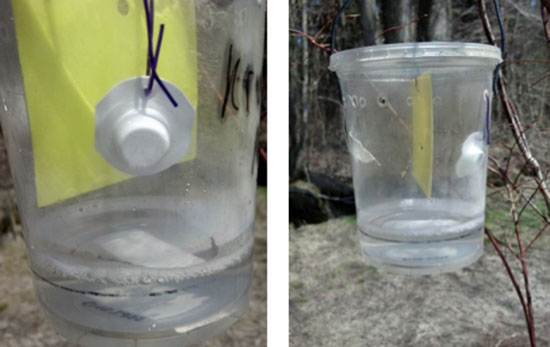
Spotted wing Drosophila traps baited with a Trecé lure, with soapy water as a drowning agent.
Rick Weinzierl (217-244-2126; weinzier@illinois.edu)
Vegetable Production and Pest Management
Catfacing of Tomatoes
Liz Maynard of Purdue University posted a great article in the most recent issue of Purdue's Vegetable Crops Hotline about catfacing of tomatoes. Liz notes that "The disorder results from disruptions to normal development of the flower well before it blooms. Flowers that produce markedly catfaced fruit have more than the typical 5 or 6 petals, and the ovary at the base of the flower is larger than normal and may be deformed." Use this link to see the article and some photos that help explain catfacing of tomatoes -- http://www.btny.purdue.edu/pubs/vegcrop/VCH2014/VCH583.pdf.
Corn Earworm
We started operating our corn earworm traps at Urbana on May 19 and have caught corn earworm moths most nights since then (as many as 25 per night on a couple of occasions). I encourage sweet corn growers and high-tunnel tomato growers to set up and use traps as soon as corn is silking or tomatoes are setting fruit – which has been going on for a several days now. Until corn fields in your area begin to silk, corn earworm moths will be especially attracted to tomatoes. Several insecticides are effective against corn earworm and labeled on tomatoes ... see the 2014 Midwest Vegetable Production Guide for an extensive listing.
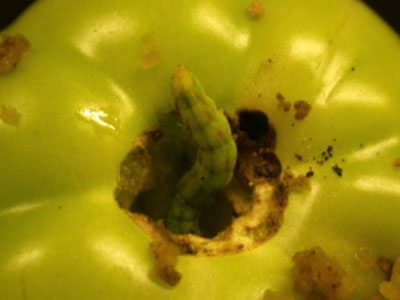
Corn earworm (= tomato fruitworm) on tomato.
Rick Weinzierl (217-244-2126; weinzier@illinois.edu)
Colorado Potato Beetle

Left to right: Colorado potato beetle adult, eggs, and larva. (Photos (L to R) from University of Kentucky, South Dakota State University, and Phil Nixon, University of Illinois.)
Adult Colorado potato beetles overwinter in the soil and become active in May; they move to solanaceous plants and begin to feed and lay eggs. As is often pointed out in winter programs where we talk about pre-season planning, potato beetles are weak fliers, so locating new fields as far as possible from last year's infestations reduces the number that reach a new planting. In addition to crop rotation, growers can use trenching, mulching, and trap crops (such as early plantings of potatoes only around field edges to concentrate egg-laying in one area for spraying).
In most of Illinois, growers have NOT encountered severe problems with insecticide resistance in local populations of the Colorado potato beetle, but managing insecticide resistance in this insect is a key concern wherever it occurs. For the most part, individual growers control their own destiny on this issue. Using cultural controls (crop rotation, trenching, and mulching, and flaming), using insecticides only when populations reach threshold levels, and rotating among different classes of insecticides are the key steps that can slow the evolution of resistance.
Thresholds for Colorado potato beetle control are:
- Spring adults on young plants: 20 to 30 percent defoliation or, more conservatively, 2 adults per plant
- Summer larvae and adults, during bloom: 5 to 10 percent defoliation, 5 larvae per plant, or 3 to 5 adults per plant
Insecticides labeled for foliar application to potatoes for Colorado potato beetle control include:
- Organochlorines. Endosulfan
- Carbamates: Sevin
- Pyrethroids: Ambush / Pounce, Asana, Baythroid, Mustang Max, Warrior
- Neonicotinoids: Actara, Admire Pro, Assail
- Diamides. Coragen
- Avermectins: Agri-Mek
- Dusts and abrasives: Cryolite, Kryocide, Surround (OMRI-approved)
- Microbials: Novodor
- Botanicals: Pyganic (OMRI-approved)
- Others: Avaunt, Blackhawk, Entrust (OMRI-approved), Radiant, Rimon, SpinTor
See product labels and the 2004 Midwest Vegetable Production Guide for rates and restrictions. For resistance management, follow label directions about not using the same product or products from the same class repeatedly throughout the season. (And if the label doesn't direct against such an unwise practice, DON'T do it anyway.)
Rick Weinzierl (217-244-2126; weinzier@illinois.edu)
Less Seriously ...
a couple of definitions
- Gross ignorance. 144 times worse than just normal ignorance
- Wit lag. The delay between the delivery of a good joke and its comprehension
University of Illinois Extension Specialists in Fruit and Vegetable Production & Pest Management
Extension Educators – Local Food Systems and Small Farms |
||
Bronwyn Aly, Gallatin, Hamilton, Hardin, Pope, Saline, and White counties |
618-382-2662 |
|
Katie Bell, Franklin, Jackson, Perry, Randolph, & Williamson counties |
618-687-1727 |
|
Sarah Farley, Lake & McHenry counties |
847-223-8627 |
|
Nick Frillman, Woodford, Livingston, & McLean counties |
309-663-8306 |
|
Laurie George, Bond, Clinton, Jefferson, Marion, & Washington counties |
618-548-1446 |
|
Zachary Grant, Cook County | 708-679-6889 | |
Doug Gucker, DeWitt, Macon, and Piatt counties |
217-877-6042 |
|
Erin Harper, Champaign, Ford, Iroquois, and Vermillion counties |
217-333-7672 |
|
Grace Margherio, Jackie Joyner-Kersee Center, St. Clair County |
217-244-3547 |
|
Grant McCarty, Jo Daviess, Stephenson, and Winnebago counties |
815-235-4125 |
|
Katie Parker, Adams, Brown, Hancock, Pike and Schuyler counties |
217-223-8380 |
|
Kathryn Pereira, Cook County |
773-233-2900 |
|
James Theuri, Grundy, Kankakee, and Will counties |
815-933-8337 |
|
Extension Educators – Horticulture |
||
Chris Enroth, Henderson, Knox, McDonough, and Warren counties |
309-837-3939 |
|
Richard Hentschel, DuPage, Kane, and Kendall counties |
630-584-6166 |
|
Andrew Holsinger, Christian, Jersey, Macoupin, & Montgomery counties |
217-532-3941 |
|
Extension Educators - Commercial Agriculture |
||
Elizabeth Wahle, Fruit & Vegetable Production |
618-344-4230 |
|
Nathan Johanning, Madison, Monroe & St. Clair counties |
618-939-3434 |
|
Campus-based Extension Specialists |
||
Kacie Athey, Entomology |
217-244-9916 |
|
Mohammad Babadoost, Plant Pathology |
217-333-1523 |
|